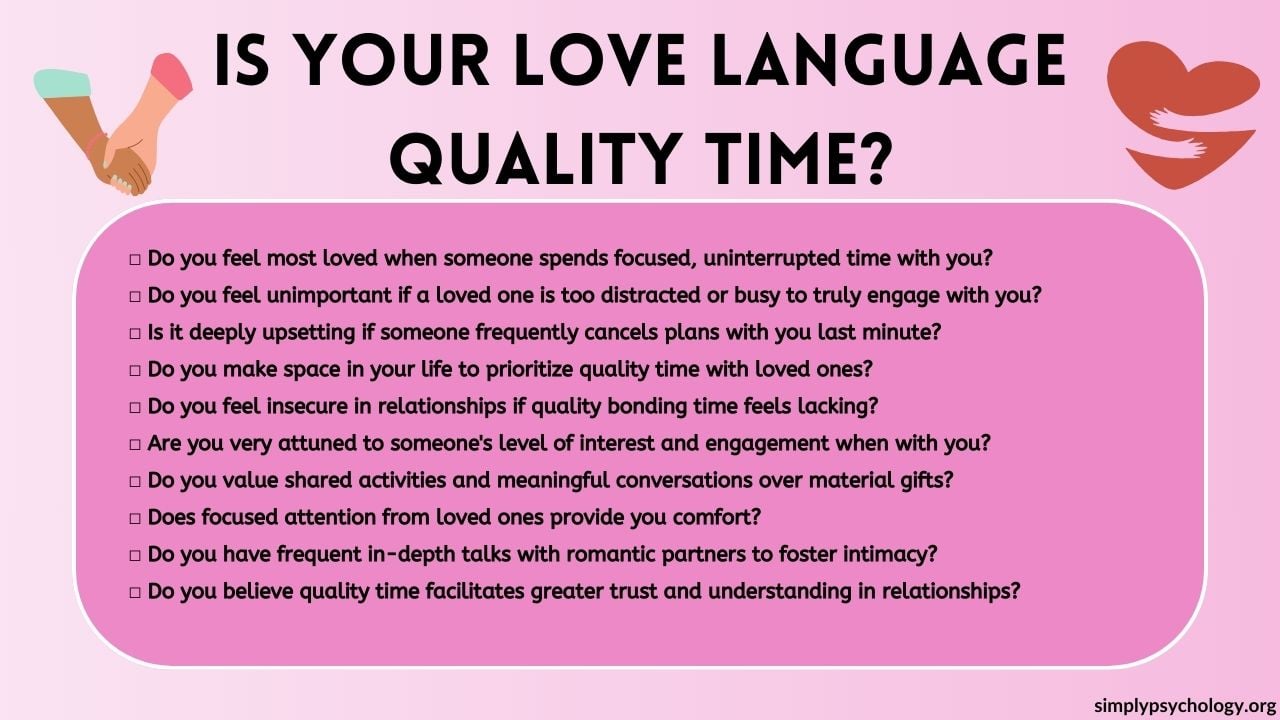Quality time is one of Dr. Gary Chapman’s five love languages, focusing on the act of giving someone your undivided attention and engagement during shared activities or conversations. This focused time together, free from distractions, signifies deep love and connection, nurturing the bond between couples.
Dr. Chapman is a psychologist-anthropologist and the author of the book “The Five Love Languages,” published in 1992. Love languages, as a concept, describe the way someone expresses and receives love.

What is quality time as a love language?
Quality time reflects people who feel fulfilled and loved when someone makes an active effort to spend time with them (Chapman & Chapman, (2010).
This can range from doing certain activities together, and finding a shared hobby, working towards goals together, or even just having meaningful talks and bonding time.
It does not only focus on sharing the same physical space but highlights the importance of being present, “in the moment,” and fully engaged with the person.
Similarly, a lack of effort to spend time together and a disinterest in dedicated, focused attention can be extra hurtful to people with this love language.
Quality time is not gender or age-specific (Chapman & Campbell, 2008); anyone can have a preference or disinclination for them, which can also change over time as it is not a rigid concept.
Quality time examples
Below are some examples of ways to spend quality time with a loved one:
- Go for a walk or a hike
- Cook a meal or bake a cake
- Visit a museum or art gallery
- Go to the cinema or theatre
- Attend a sporting event
- Have a nice dinner in candlelight
- Try a new hobby
- Volunteer
- Go on a shopping spree
- Take a class, e.g., cooking or dancing
- Binge-watch a new series
How do you know if your love language is quality time?
One of the easiest ways to determine your primary love language is by taking the free quiz developed by Dr. Chapman himself (available on the five love language website).
It will ask you a series of questions to help you reflect on your preferences and what is most meaningful to you.
Additionally, there are a few things you can reflect on yourself to help you decide if quality time is your love language. You could ask yourself the following questions:
- Do you feel the happiest and most fulfilled when you spend quality time with your partner?
- If your partner is busy and occupied, are you more likely to feel neglected or unimportant?
- Do you feel the need to spend quality time with your partner in order to feel secure and loved in your relationship?
- Are you someone who actively makes space for such quality time with your loved ones over other activities, such as getting them a gift?
If quality time is your love language, you focus on spending time with your loved ones, and it is highly important for you to frequently engage in this.
When you receive your partner’s undivided attention and are prioritized in their life, you feel the most loved and valued.
Even if they are expressing their love in other formats, such as physical touch or with positive words, that emotional connection you feel when being together and focused on each other feels unmatched for you.
Many people unconsciously use their preferred love language to showcase their emotions to someone, as that is how expressing care comes the most naturally to them. Hence, you may also be someone who enjoys giving others your quality time.
For example, you may actively make time in your schedule to spend time with people you care about. You may also ensure that when you are with them, you give your undivided attention, actively listen, and engage in meaningful conversations.

How can you show quality time to your partner?
When it comes to showing quality time to your partner, it is all about creating focused and intentional opportunities to connect with them. There are several ways you can do this to showcase your love, care, and affection.
Actively listen
The overall key principle to have in mind is to be fully present in the moment and focus on giving them your uninterrupted time.
Actively listening in the forms of paying attention, making eye contact, asking questions, and being genuinely interested in their points of view will highlight your care for them in a manner they receive the best.
Focus on quality, not quantity
If you are struggling to differentiate spending time from spending quality time, try thinking about it from a “quantity does not equal quality” perspective.
Just because you are both occupying the same space does not equate to you having a meaningful and connected moment.
Minimize any potential distractions that could interfere, such as work emails or social media, and create a space conducive to you giving your full attention.
“Quantity of time is not it. I get irritated if I’m with someone 24/7. But I do like spending quality time with a person. Even if we’re doing two different things in the same room, that’s part of quality time to me.”
‘Jada’
Be mentally present
Spending quality time should be reflected in you being both physically present, i.e., maintaining eye contact, nodding to show you are listening, sitting close to them, etc., but also mentally present.
Ensure you are giving your partner your undivided, focused attention and truly engage in your time spent together. This may mean eliminating distractions such as putting your phone away or turning off the TV.
Proactively make plans
Spending quality time with your partner can also be rather flexible in nature.
If you are just starting to incorporate this love language in your relationship, having an open discussion with them to identify some types of quality time they would enjoy the best would be a good starting point.
You can then begin to integrate them into your daily schedule, proactively make plans to spend time together and begin to make it part of your weekly relationship routine.
“To me, it means that you spend as much time as you can together. You are each other’s default. You assume that you’ll be doing something together on the weekends and for holidays. You make plans with each other and follow through.”
‘Sam’
Be spontaneous
On the other hand, it does not have to be rigid and structured. Spontaneity can be an excellent addition to keep things fun and exciting.
Take an interest in your partner’s life, identify what they enjoy doing, and plan a surprise date.
Showcase your affection
Lastly, do not forget to showcase your appreciation and affection. When spending time together, you can combine quality time with other forms of showing love, such as physical touch or words of affirmation.
This can help elevate your time together and really target that “quality over quantity” mantra.
Overall, sharing loving moments with your partner is about making them feel appreciated, valued, and connected to you.
By creating space for such meaningful interaction, you will not only display your love to them but strengthen your emotional bond and lay strong foundations for a healthy relationship.
Why is quality time important?

Quality time is important as it forms the building block and foundation for a happy, healthy, and long-lasting relationship.
It offers several benefits and can help serve various functions. This can be true for both romantic relationships as well as platonic friendships and family relationships.
Builds relationships
With quality time, you are creating purposeful time and space to share intimate moments with loved ones. By doing so, you can demonstrate care and affection, which in turn generates opportunities to strengthen and build your relationships.
This has also been reflected in scientific evidence where researchers identified the factor of “quality time” as having a significant impact on the longevity and overall personal satisfaction of relationships (Baxter, L. A., & Bullis, 1986).
Improves communication
A key principle underlying quality time is the enablement of communication. When spending quality time with a loved one, you are, by proxy allowing for meaningful distraction-free discussions to be held.
This, in turn, improves mutual understanding, can increase feelings of intimacy and trust, and helps prevent emotional distance.
Makes new memories
Quality time provides opportunities for creating and sharing moments with loved ones, resulting in the creation of new memories. Such shared times are then often points of reminiscing and happy times for years to come.
You may even have photographs or videos of spending quality time with loved ones, further enhancing any trips down memory lane.
Keeps us connected
In today’s fast-paced environment, where we are incredibly becoming even more interconnected, our days are consumed with electronics, and our attention is pulled in every which way.
This makes it easy to lose track of time, drown in social media and lose sight of not only being connected online but also connected in real life.
Thus, actively making an effort to prioritize quality time with loved ones can not only act as a “screen detox” but can keep us grounded and in touch with the people that matter around us.
Importance of quality time in friendships
In friendships, quality time can serve as a way to strengthen emotional bonds, validate feelings as you are creating an environment of focused attention, and provide opportunities to share activities.
Regardless of the form this can take, e.g., catching up over coffee or going on a trip with your friend, quality time fosters opportunities for shared experiences, creating new memories, and developing meaningful connections.
Importance of quality time in family relationships
In family relationships, quality time generates opportunities for everyone to check in with each other, stay in the know of what is happening in their lives, and can help foster a sense of togetherness within the family unit.
Ensuring designated time for meaningful connections, e.g., reading your children a bedtime story or going on a family outing, can help build a stronger emotional bond and even support children’s development and sense of security and attachment (Kalil, A., & Mayer, S. E. (2016).
What can hurt a person whose love language is quality time?

“What makes me feel unloved is when I’m forced to spend holidays alone, when I feel like no one is listening or paying any attention to me, or that people are leaving me out of things on purpose.”
‘Johanna’
For a person whose love language is quality time, there are a few actions that can hurt them and make them feel unloved or undervalued in a relationship.
One of the primary things to look out for is being distracted or seeming uninterested when spending time together.
Your partner wants to feel like they have your undivided attention, so resist the urge to multitask and remove distractions such as phones or laptops.
Focusing on other obligations when you are supposed to be spending quality time together can also signal a lack of effort or even disinterest. This, in turn, can make your loved one feel disconnected from you and begin to create a gap in your emotional connection.
Canceling plans is also something that should be avoided where possible (but this, of course, is not always unavoidable).
As an overall rule of thumb, frequently canceling plans, especially last minute, can signal that you do not value your time spent together and can cause significant disappointment for your partner and make them feel unloved.
Lastly, avoid complaining that your partner wants to spend quality time together, and do not shame them or devalue their need to feel love this way.
Make a conscious effort to be compassionate and understanding that this is how they best receive love. Try to communicate and work together to ensure they feel valued and emotionally connected.
Frequently Asked Questions
How can you tell your partner that you need more quality time?
If you would like to spend some more quality time with your partner but are unsure as to how to approach it, here are some simple steps for you to follow.
Firstly, reflect on what it is that you need and express why it is important to you; it will make it much easier to articulate to your partner if you have self-analyzed first.
Secondly, as soon as you find a suitable time and place, e.g., when you are both relaxed and at home, have an honest discussion with them.
Communication is key, so it is important that you are direct and clear about your need to spend more quality time together; it could also help if you give some examples of how you want to spend quality time together.
Lastly, actively listen to your partner and try to meet in the middle. Work together on finding a solution that honors you both so that you can strengthen the relationship.
Can a relationship last without quality time?
Every relationship is unique, and in a healthy partnership, there will be periods where time together or communication may be reduced (e.g., work/family commitments).
However, it is rare to have a lasting positive relationship without quality bonding time.
Quality time serves an important function in a partnership and aids in deepening the emotional connection, relationship satisfaction, and feeling secure in your connection.
Heavily reduced or sparse pockets of quality time can lead to compromised emotional bonds, which in turn can result in one or both partners feeling neglected or unloved, further increasing the chances of conflict and relationship damage.
Does texting count as quality time?
Texting can certainly count as spending quality time with your loved ones as you share personal moments throughout your day.
However, it should not make up the entirety of the meaningful time you allocate to your loved ones.
Quality time is typically centered around intentional time spent together where all parties give their undivided attention and engagement.
Texting can often be interrupted by distractions such as social media or emails and while it can have a central role in driving daily connection, it should never substitute high-quality in-person time.
Some exceptions may apply where there are limitations to face-to-face contact, such as in long-distance relationships.
Which love language is compatible with quality time?
Quality time is one of the most versatile love languages, meaning it can be combined with almost all other love languages to help show your love and affection. However, there are two that align best.
The first one is acts of service. Engaging in shared activities together and helping your partner out can be a wonderful way to spend time together and strengthen your relationship’s emotional bond.
The second one is physical touch. Whenever you spend time with your loved one, you can engage in physical activities such as hugs and cuddling. For example, if you are watching a movie, you can also snuggle together.
Always check with your partner if they are comfortable with physical touch first, especially if you are in the beginning stages of your relationship.
How can you show the quality time love language with family or friends?
Quality time is important not only for romantic relationships but also platonic and family relationships as well.
Here are a few examples of how you can show the quality time love langue to your family and friends:
– Make time in your schedule for them. This could be having meals together or meeting up regularly for coffee.
– Actively engage when listening and conversing. Ensure you are present and give them your undivided attention. For example, if you are having dinner, leave your phone off the table to avoid distractions and make a conscious effort to engage in discussions happening around you.
– Plan fun activities that you can do together. This could range from a fun outing over the weekend to a staycation to even organizing an overseas trip. However big or small, you will be sure to make wonderful and lasting memories.
References
Baxter, L. A., & Bullis, C. (1986). Turning points in developing romantic relationships. Human communication research, 12(4), 469-493.
Chapman, G. D. (1992). The five love languages. Northfield Pub.
Chapman, G., & Campbell, R. (2008). The five love languages of children. Moody Publishers.
Chapman, G. D., & Chapman, G. (2010). The five love languages: The secret to love that lasts. Northfield Pub.
Kalil, A., & Mayer, S. E. (2016). Understanding the importance of parental time with children: Comment on Milkie, Nomaguchi, and Denny (2015). Journal of Marriage and Family, 78(1), 262-265.


